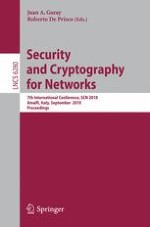2010 | Book
Security and Cryptography for Networks
7th International Conference, SCN 2010, Amalfi, Italy, September 13-15, 2010. Proceedings
Editors: Juan A. Garay, Roberto De Prisco
Publisher: Springer Berlin Heidelberg
Book Series : Lecture Notes in Computer Science

